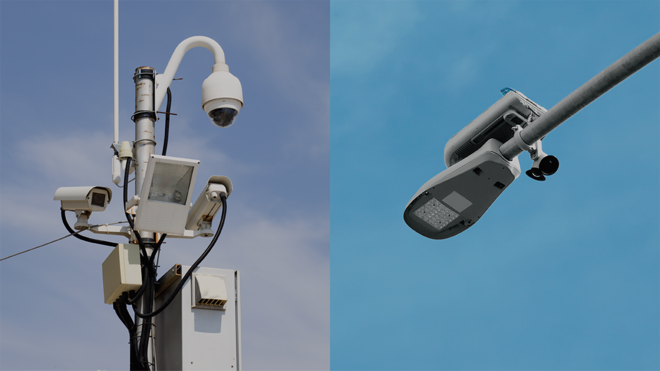Overcoming deployment roadblocks for public safety cameras

Video cameras can be welcome force multipliers for short-staffed jurisdictions with rising rates of crime — which, judging by the statistics, is most places. Ninety-two percent of U.S. state and local law enforcement agencies have fewer than 100 full-time members. Many struggle with recruitment and retention. At the same time, property and larceny-theft crime rates are up, and gun-related deaths continue to be high.
What keeps many police departments from taking advantage of camera technologies are the challenges associated with deploying and maintaining them. Cameras need infrastructure — somewhere to put them and sources of power. Purpose-built poles, existing communications poles and other people’s buildings aren’t so easy to make work.
Public safety cameras have specific deployment specifications. They need to be high up, out of harm’s reach and with good visibility. They also need to be spaced appropriately to provide effective coverage.
Existing communications poles may sAeem like a good option, but cameras then need to be mounted with bulky cabinets of support equipment, creating unsightly “Frankenpoles” of un-integrated devices.
Standing up new poles, on the other hand, requires site selection, permitting and construction that can be time-consuming and bureaucratically bogged down, and negotiating the use of building exteriors with property owners comes with its own headaches. Many sites lack readily available power or connectivity, necessitating additional construction and services.
The costs associated with new builds especially can be prohibitive for departments with tight budgets. Even with available special public safety project funding, the expense of managing and maintaining dedicated infrastructure for public safety cameras can be hard to sustain over the long term.
For all these reasons, streetlights are obvious candidates for mounting video cameras.
Why streetlights make sense for public safety cameras
As existing infrastructure, streetlights eliminate the costs and time associated with site permits and construction. They’re already powered and are at the right height for camera placement and transmitting wireless signals. Some even have fiber connectivity. This makes it easy to turn them into intelligent network access points with control technologies to provide an integrated, multipurpose platform for public safety applications.
In the streetlight scenario, the fixture itself supplies power to the camera, which can be managed remotely in a centralized way — making it easier to monitor and maintain.
A non-proprietary streetlight platform that can integrate a range of third-party technologies gives police the flexibility to choose and use the cameras they prefer, including ones they’ve already invested in. That makes an even more compelling business case for streetlight-based deployments of public safety cameras and paves the way to roll out everything from smart lighting to gunshot detection software.
Recognizing that departments may not have the resources to manage a streetlight-based camera network themselves, some vendors (including Ubicquia) will offer a managed service option and take on responsibility for ongoing operation and maintenance.
Proving it on the ground
In December 2023, the San Diego Police Department kicked off a 500-camera deployment project focused on automated license plate recognition to gather evidentiary video and support investigations. We’ll be writing more about that in the weeks to come. The department has already made gains with burglary, robbery, vehicle theft and even some homicide investigations in the few months since the first wave of cameras was installed.
As demonstrated in San Diego, the staged deployment approach is another advantage of using streetlights to support video cameras. Not all departments have the means to roll out thousands of cameras at once. Since streetlights already exist and will always be available, departments can start with a focused use case and scale up over time — while creating a strong sense of community safety in the process.
Our next blog in this series will take a closer look at some of the best practices for deploying public safety cameras for public safety.

